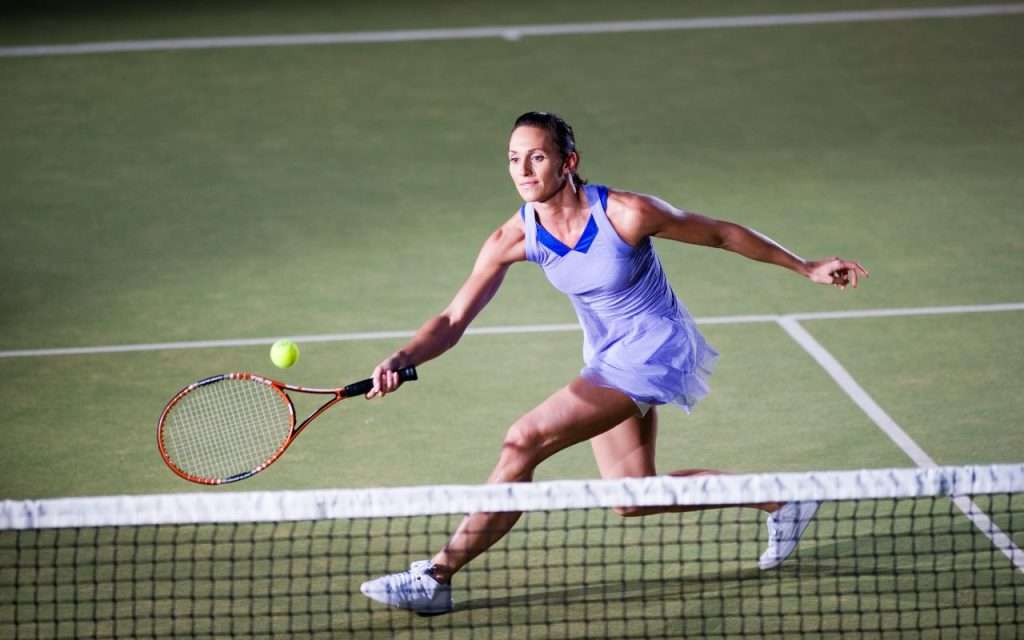
Learning and mastering the countless types of tennis shots can seem overwhelming at first. Are you just starting and wondering what shot will be easiest to make?
Or do you consider yourself more of an experienced player, wanting to expand your shots the next time you head to the court? Regardless, it’s always good to know which shots work for you and which do not.
Luckily, we’ve compiled a list of 14 tennis shots everyone should know, so keep reading!
1. Topspin Forehand
The first tennis shot we’ll discuss is the topspin forehand. Players must choose the correct grip to use this shot during a game. Players often want to brush the ball and get it rotating, creating a topspin for their shot.
Although many tennis players create topspin with their forehands without realizing it, this shot is essential for playing the sport. Forehands require you to make the shot by swinging the racket across your body with the hand moving palm-first.
Here’s how to create the perfect topspin forehand shot:
- Position your racket face so that it is slightly closed.
- Brush up on the back of the ball.
- Hit your tennis ball on the front of your body.
- Pronate your wrist (palm or forearm faces down).
- Make sure and follow through.
Our post on choosing a forehand grip may also be helpful.
2. Topspin Backhand
Moving to the backhand volley or topspin backhand, this is another popular shot to make for both experienced and newer tennis players. You’ll create more topspin using your regular backhand grip and positioning like the topspin forehand.
Of course, this can depend on how you hit the backhand: with one or two hands. Most players use both hands for their backhand shot, although many experts consider a one-handed backhand ideal for creating better topspin.
Here’s how to create the perfect topspin backhand shot:
- Use the Western grip for your racket (hold the racket with your left hand with strings facing down).
- Face your body towards the net.
- Hold your racket (at the throat) with your non-dominant hand and bring it to waist level.
- If using the eastern grip, players want to meet the ball in front of their bodies.
- Your racket head should be dropped down toward the ground just before contact.
- Meet the ball in front of your body (eyes glued to the point of contact and body in a sideways position.
- After contact, the racket should move upward by one foot. This indicates that the brushing effect of your racket faces the ball. The back foot should come forward.
- Follow through after hitting the shot (shoulder comes forward). Your body should be facing the net.
People using both hands want to utilize the eastern grip for the topspin backhand.
3. Flat Forehand
Moving to the flat forehand shot, this is a great choice for players using various grips. With this forehand, you can play with the eastern forehand grip, semi-western, or even the full-western grip. The main point of creating a flat shot is to reduce topspin and hit more aggressively.
However, the full Western grip can be harder to create a flat forehand, so keep that in mind.
To create a flat forehand shot, you need to ensure the ball is being hit above net level. Many people try to create a flat-back shot hit from below the net, which is incredibly difficult. Therefore, the higher your ball is, the better this shot will be.
Here’s how to play using the flat forehand shot:
- Look for the correct ball to “attack” (should be above net level).
- Use the right swing path: this should be outwards toward the target.
- You want your ball to stay on the strings of your racket as long as possible.
- Use your body weight to hit the ball, stepping forward with the left leg.
- Follow through after hitting the ball: your hitting shoulder will come forward.
Here is a video detailing these steps: How To Hit The Perfect Flat Tennis Forehand In 3 Simple Steps
4. Flat Backhand
Next, the flat backhand is similar to the flat forehand: you reduce the ball’s topspin and focus on hitting it at a neutral level. Like any backhand, you should start with two hands, gradually moving to a single hand as you improve.
The objective with the flat backhand and forehand is to give your opponent less time to react. The ball moves faster and stronger over the net without the added topspin.
A flat backhand will give you a stronger stroke, especially with a double-handed placement.
Here are the steps for doing this successfully:
- Bend your knees and bend your elbow slightly.
- Bending your elbow will allow for flexibility in your wrist.
- As the ball approaches you, take your racket back and turn your shoulders.
- The earlier a player reaches this position, the more time they have with the shot.
- Remember to follow through.
Note: flat shots with little topspin won’t bounce high but skid across the court.
5. Groundstrokes
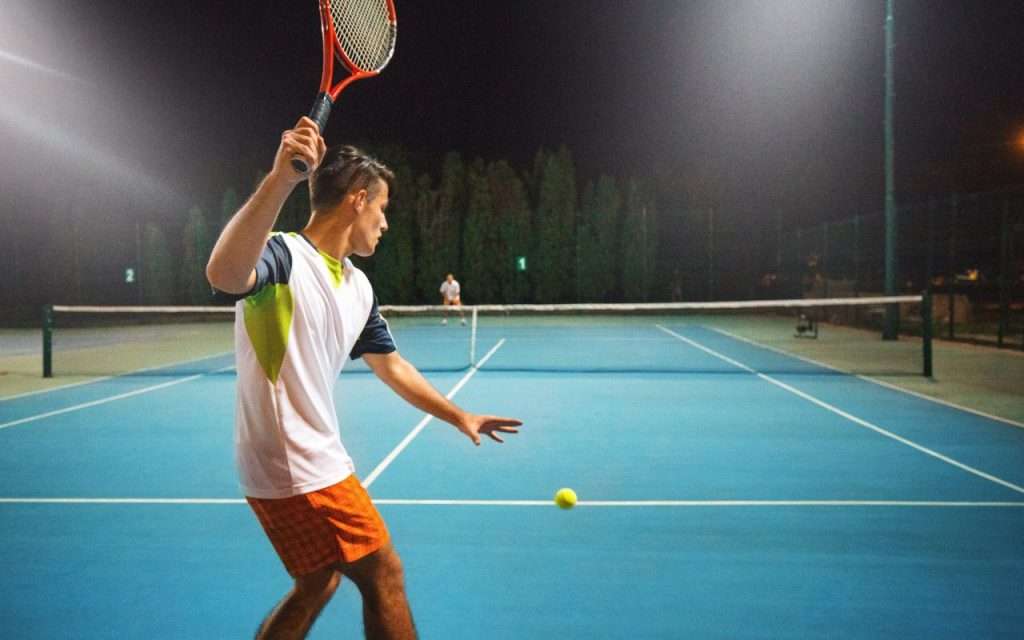
One of the more popular shots on this list is groundstrokes. This shot is the most common in a tennis match, often being the most associated with the sport. One thing to remember with groundstrokes is that they are hit standing a few feet from the baseline, as a forehand or backhand.
Like many of the basic tennis shots on this list, groundstrokes apply to forehands and backhands: so it’s a good idea to master this on both.
These 15 tips for beginner tennis players will also help you get started.
Forehand Groundstrokes
To master forehand groundstrokes, the following tips will be helpful:
- To use this shot, players must bring their racket across their body, then toward where they want the ball to land.
- Right-handed players will start on the right side of their body.
- This tennis stroke ends with a full follow-through.
- Most times, this shot is executed using topspin.
Backhand Groundstrokes
Here are some tips for using backhand groundstrokes as well:
- Like the forehand groundstroke, players want to swing the racket around their bodies.
- This shot is mainly used on baseline rallies.
- You can use two hands to complete this shot.
- The two-handed backhand groundstroke is more powerful than a single-handed one.
6. Inside-Out Forehand
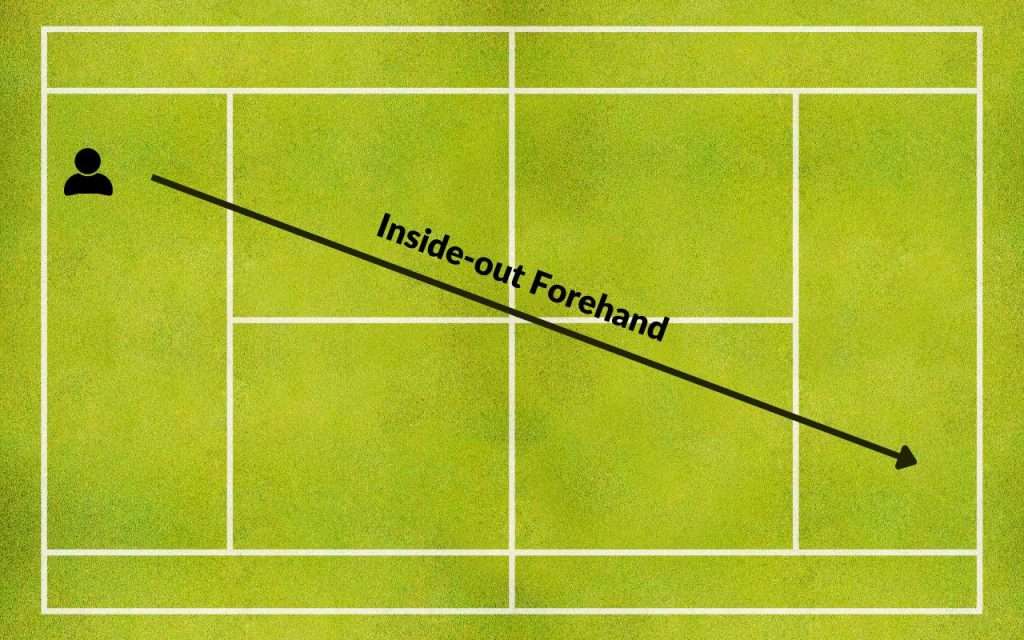
Another must-know shot for tennis players is the inside-out forehand. Typically, you want to run around your backhand and hit a forehand cross-court. This shot is also perfect for people wanting to hit a forehand because they have weaker backhands, offering more strength.
According to various pros, hitting a higher ball as an inside-out forehand (particularly a slower ball hit with a backspin) is an easy way to score against an opponent.
Here are some tips for hitting this shot:
- Avoid turning sideways as you move around the ball.
- Focus on staying open.
- You want your hips to face the net more as you shuffle around the ball.
- Most people hit this shot from a semi-open stance.
This inside-out forehand instruction video may also be helpful.
7. Inside-In Forehand

The next tennis shot to know is the inside-in forehand. To explain this, in tennis strokes, players will hit an inside-in forehand while running around a backhand. Instead of hitting the forehand cross-court, you want to hit the ball down the line.
Many experts suggest hitting your inside-in forehand from or inside the baseline. This will lower the margin of error, ultimately giving you a higher chance of scoring a point.
Although many people get confused, this is a different shot than the inside-out forehand.
Here is a YouTube video explaining this tennis shot: How To Hit An Amazing Inside In Forehand
8. Inside-Out Backhand
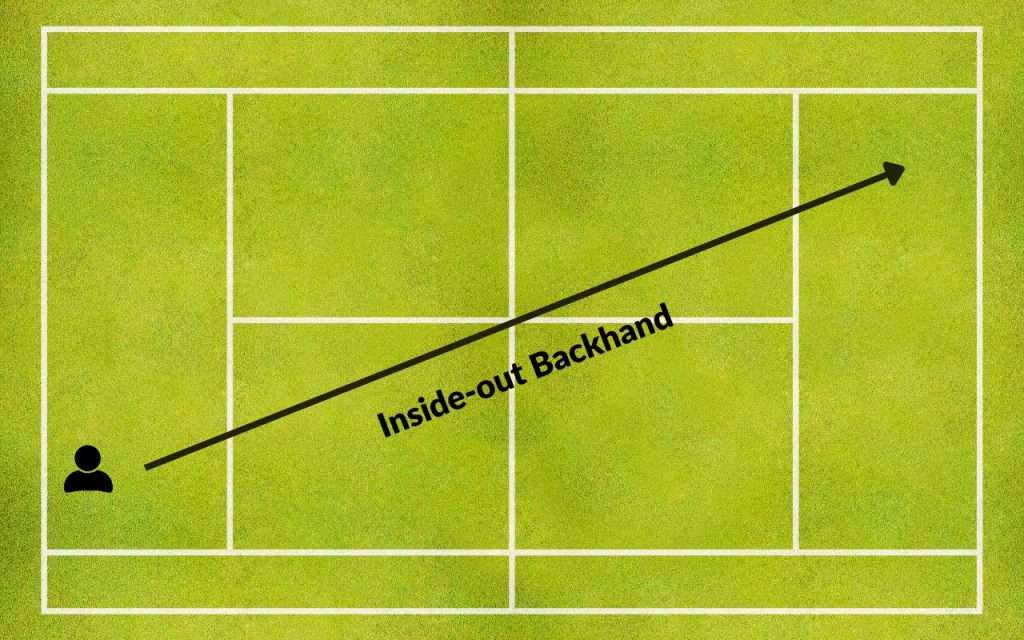
Following the inside-out volley shot* theme, we also want to introduce you to the inside-out backhand. This tennis shot is often deemed an essential return shot for doubles play and is a bit trickier to master.
Here are times to use the inside-out backhand shot:
- Right-handed players returning in the deuce court (lefty’s into the ad court).
- When your opponent serves into the T, allowing you to adjust your footwork.
- Use this as a surprise “behind” shot: you’ll want to hit the ball behind your opponent with this backhand.
- If your backhand is better than your forehand, this shot will become easier for behind shots.
- Players often use this shot if they’re out of position or with a short ball during a mid-court transition.
9. Inside-In Backhand
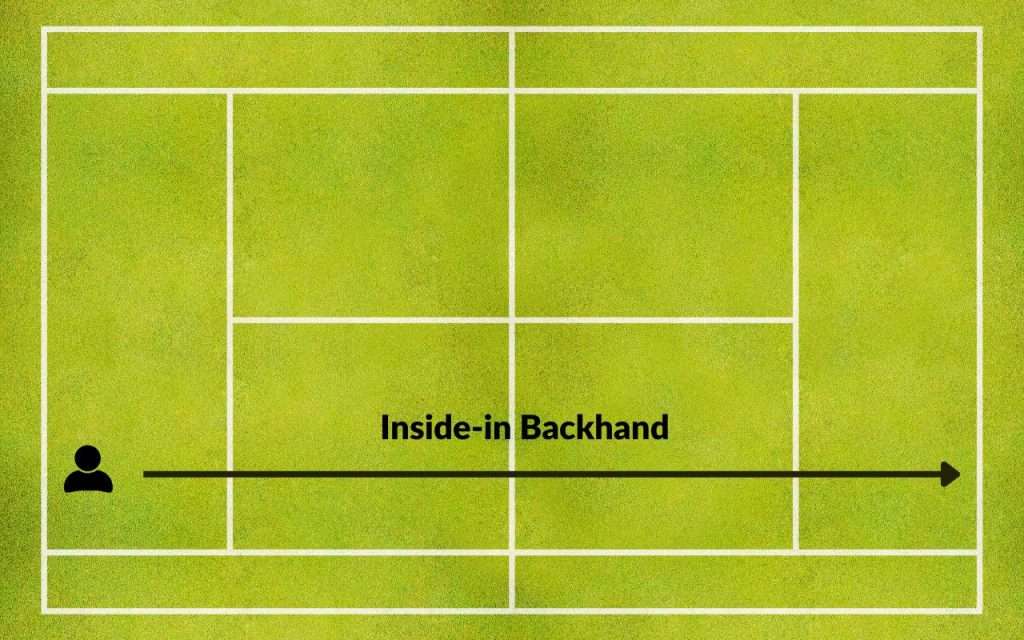
Now to the inside-in backhand; this is a tennis shot you’ll want to use in specific cases. For example, if your opponent uses a forehand volley or a slice serve, that creates the perfect opportunity for you to return the ball using the inside-in backhand.
To play this same slice shot again, you can “side step” to your right and let the slice serve curve inward. This is when you want to hit the ball using the inside-in backhand, bringing the return to the other side of your opponent’s court.
Think of this shot as a way to increase your chance of scoring a return point, especially when playing singles. Like the inside-out backhand, this shot is also tricky to learn, so the two will take time to master.
If you need help with common tennis terms mentioned in this article, check out this post: Tennis Terms (Top 6 Basic Breakdowns)
10. Flat Serve
Another shot in tennis worth understanding is the flat serve. Typically, players will use the same eastern forehand grip or continental grip for this shot, so that’s something to remember.
The flat serve is one of the most sought-after shots in tennis.
That’s because, in tennis games, it is synonymous with power and the ability to hit an ace. Many experienced pro tennis players utilize the flat serve, as it tends to be the best choice during a game. The key to this shot is hitting the ball with little to no spin.
Like a flat forehand or backhand, you also want to reduce the amount of topspin your serve creates, giving the ball a quick, aggressive return.
Here are some tips for mastering this shot:
- Grip your racket. Create a V with your thumb and forefinger.
- You want the V to be at 11 (right-handed) or one o’clock for left-handed players.
- Focus on using the continental grip for this serve, the racket at a neutral angle to the ground.
- Stand sideways with feet hip-width apart.
11. Slice Serve
Deemed one of the most crucial shots in tennis, the slice serve is one to know. This shot can create a stronger, faster tennis player and help you to score more points. The slice serve is when you add sidespin to a first or second serve.
Unlike flat serves, which may be from the back, or kick serves, basic shots that are hit “up” to add topspin, your slice serve brushes along the side of the ball. When this happens, your shot draws the opposing player out wide to the ad or deuce side.
This leaves the rest of the tennis court open to your advantage.
Here’s how to hit a slice serve:
- Get the proper grip: use the continental grip for this serve.
- Toss the ball high with your non-dominant hand. If you’re left-handed, toss with the right hand, and vice versa.
- Slice the ball as you serve: with your hitting arm, use your wrist to cut around and under the side of the ball—swing from high to low.
- Avoid pronation. You want to keep your racket in a chopping motion as you follow through the slice serve.
12. Kick Serve
Another shot to know when playing tennis is the kick serve. For this shot, you will serve the ball with a combination of topspin and sidespin, creating a ball that bounces high. Your kick serve will also result in the ball moving sideways: which is helpful after it hits the tennis court.
In plain terms, a kick serve will work best for good clearance over the net.
Unlike other, more precise shots, a kick serve works best to clear the net and easily hit the other side of the court. This service is popular among newer players but can also be used by professionals.
This serve gets its name because of how the ball bounces, jumps, or kicks off the ground due to the heavy topspin. You want to make sure and snap your wrist when hitting the ball, which will create sideways movement and excessive topspin.
Many people consider this serve a weapon in a game, as it forces the opponent to step forward and return the ball or step back and try to hit a return. The margin of error is high.
13. Specialty Shots
Regarding the specialty shots in tennis, these are the ones you want to use in unique situations. Specialty shots won’t usually be easy and aren’t the “go-to” for most players.
Here are some of the specialty shots in tennis everyone should know:
- Approach shot – can be hit as forehand or backhand: usually occur when the opposing player hits the ball short in the court. You step forward and into the ball.
- Passing shot – typically hit when your opponent is at the net: you do this to try and get the ball past the other player to score a point.
- Lob – can be hit in a few scenarios. You want to hit a forehand or backhand well over your opponent’s head to do this. The ball should land deep in the court, toward the baseline.
14. Passing Shot
Lastly, we have a passing shot. This shot is one of the more aggressive ones to play during a game, traveling far beyond where your opponent can reach and return it.
Furthermore, this shot is typically a groundstroke and is used when one’s opponent is running to the net or if they are at the net already. You want to use this shot to get the ball on the other side of where your opponent is, buying you time and a potential point.
Many professionals use this strategy during a game of singles, so that’s something to keep in mind.
Here is a video showing this shot in further detail:
Tennis Singles Strategy | Passing Shots
To Finish
Whether you’re relatively new to tennis or have played for years, learning new shots will make for a better game. We covered 10+ in this article, so hopefully, you can practice these and win your next game.
